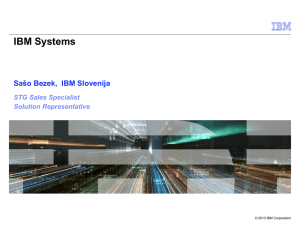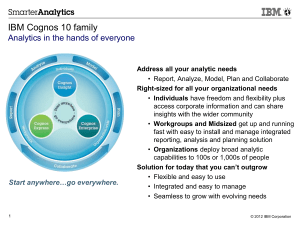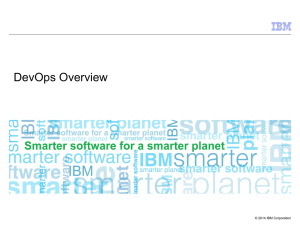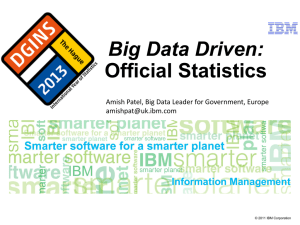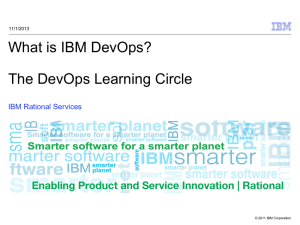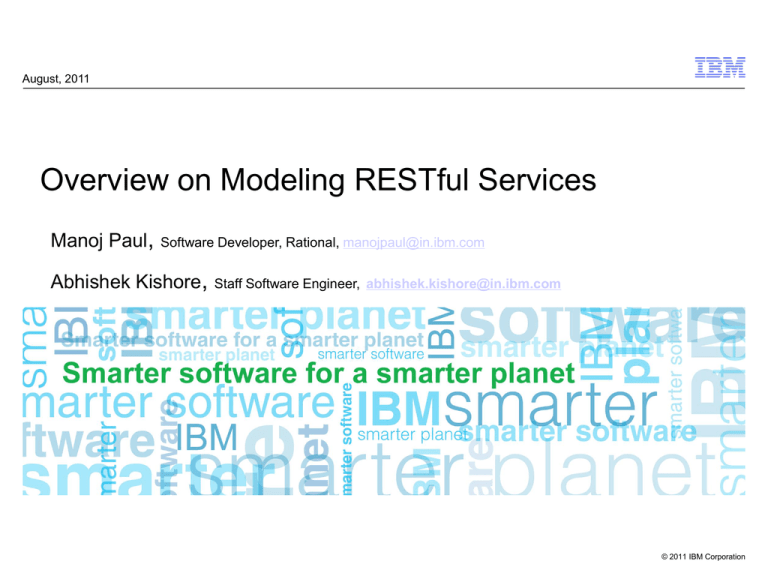
August, 2011
Overview on Modeling RESTful Services
Manoj Paul,
Software Developer, Rational, manojpaul@in.ibm.com
Abhishek Kishore,
Staff Software Engineer, abhishek.kishore@in.ibm.com
© 2011 IBM Corporation
Agenda
Model Driven Development
–
Rational Software Architect
What is REST?
–
REST Concepts
–
Why Model REST Services?
Modelling Support for REST in RSA
–
REST Service Profile and tooling support
–
Customized Sequence Diagram
–
REST Service Model Report Generation
JAX-RS Support
–
JAXRS Modelling
–
Code Generation & Reverse Engineering
© 2010 IBM Corporation
Model Driven Development
What is model-driven development/engineering?
– Development with models as the primary artifacts from which efficient implementations
are generated by the application of transformations.
Abstraction
– In MDD, we use abstraction to enable us to work with a logical view of our application,
focusing on the functionality of the system without being concerned with implementation
details
UML
–The Unified Modeling Language (UML) is typically used to create models for
MDD
– While we can use UML in an informal way, it has semantics and precise models that we
can create by using it in a consistent manner
© 2010 IBM Corporation
Model Driven Development
Automation - Transformations
– Automate generation of Artifacts from Models
– This includes the generation of code and also the generation of more
detailed models, for example generating a design model from an
analysis model
© 2010 IBM Corporation
MDD Enabled in Rational Software Architect
Leverages model-driven development
with the UML for creating wellarchitected applications and services
UML in itself is not broad/detailed for all
domains / platforms
–UML profiles allow you to customize the
language for a particular domain or
method
Built-in Transformations
–UML to C++/Java/C#*
–…
Framework for managing and
customizing transformations
© 2010 IBM Corporation
REST : REpresentational State Transfer
REST defines a set of architectural principles for designing Web services
– Focus on resources, including how resource states are addressed and transferred over
HTTP.
A simpler alternative to SOAP- and Web Services Description Language
(WSDL)-based Web services
Has gained widespread acceptance across the Web
– Adoption of REST by mainstream Web 2.0 service providers—including Yahoo, Google,
and Facebook
REST Web service follows four
basic design principles:
– Use HTTP methods explicitly.
– Be stateless.
– Expose directory structure-like URIs.
– Representation of resource state
© 2010 IBM Corporation
REST Concepts
One-to-one mapping between create, read, update, and delete (CRUD)
operations
– To create a resource on the server, use POST.
– To retrieve a resource, use GET.
– To change the state of a resource or to update it, use PUT.
– To remove or delete a resource, use DELETE.
Web services be stateless
Expose directory structure-like URIs
– hierarchical, rooted at a single path, and branching from it are subpaths
– http://www.bookmarkservice.com/bookmarks/users/{john}
Resource Representation
– A resource representation typically reflects the current state of a resource
– Has to do with the format of the data that the application and service exchange in the
request/response payload or in the HTTP body
© 2010 IBM Corporation
Why Model REST Services?
Traditional Approach
– Describe the design on REST
based Services in terms of URIs,
Resource, HTTP methods and
their representations
– Publish as documentation to
enable its implementation and
enable the clients of the service
– Lack of any formal notation
Resource
URI
HTTP Methods Supported
Users
/users
GET
getListofUsers
POST
createUser
GET
getUser
DELETE
deleteUser
GET
getListofBookmarks
POST
createBookmark
GET
getBookmark
DELETE
deleteBookmark
User
Bookmarks
Bookmark
/users/{username}
/users/{username}/bookmark
s
/users/{username}/bookmark
s/{bookmarkId}
How do you design your RESTful Web Service?
How do you implement this design?
How do you publish your RESTful services to consumers?
How do you evolve this design and implementation?
© 2010 IBM Corporation
Why Model REST Services?
MDD-based Approach
– Rational Software Architect v8.0.3 supports modeling
and implementation of RESTful Web Services.
– The modeling support enables you to create UML
models for your web service to describe your web
service.
– On the implementation side, you generate Java code to
generate your web service using JAX-RS.
© 2010 IBM Corporation
Modelling REST Services
The key modeling elements:
Rest Stereotype
UML Element
–
RESOURCE
Resource
Class, Interface
–
Resource Path
Application
Class
–
Resource Methods
GET
Operation
–
Resource Input/Output types
PUT
Operation
–
Param Types
POST
Operation
DELETE
Operation
HEAD
Operation
Param
Parameter
Path
Dependency
© 2010 IBM Corporation
RESTful Service Modeling – Palette Support
© 2010 IBM Corporation
RESTful Service Modeling
Capture parameter types
Capture input/output types for resources/resource
methods
REST Modeling Tooling Support
Capture return codes for resource methods
© 2010 IBM Corporation
Modeling RESTful interactions in Sequence Diagrams
You can model the typical interactions with the clients of your RESTful Web
Service using the sequence diagrams.
HTTP Request on Sequence
Diagram
HTTP Response on Sequence
Diagram
© 2010 IBM Corporation
Modeling RESTful interactions in Sequence Diagrams
You can also detail each request or response in terms of the URI, headers and
content using the HTTP properties tab for a message
© 2010 IBM Corporation
Modeling RESTful interactions in Sequence Diagrams
To detail implementation side, you can further details the sequence diagram with
calls to actual Resource classes
Simply drag your Resource classes on the sequence diagrams and draw
messages to it
© 2010 IBM Corporation
BIRT reports for REST services
Generating documentation using BIRT Reports
© 2010 IBM Corporation
JAX-RS Support
© 2010 IBM Corporation
JAX-RS: The Java API for RESTful Web Services
JAX-RS: Java API for RESTful Web Services provides Java API for creating
REST Services
JAX-RS uses annotations to
simplify the development and
deployment of web services
– @Path, specifies the relative path for a resource class.
– @GET,@PUT, @POST,@DELETE, specifies the HTTP
request type of a resource method.
– @Produces, specifies the returned MIME media types etc
– ….
@Path("widgets")
@Produces(“text/plain”)
public class WidgetsResource {
@GET
@Path("offers")
public WidgetList getDiscounted() {
}
@Path("{id}")
public WidgetResource findWidget(@PathParam("id") String id) {
return new WidgetResource(id);
}
}
public class WidgetResource {
public WidgetResource(String id) {
@GET
public Widget getDetails() {
}
}
}
© 2010 IBM Corporation
JAX-RS: The Java API for RESTful Web Services
Sub-Resource Method
Sub-Resource Locator
public class World{
@PUT
public void create(){…}
@Path({“continents”})
@GET
public void get(){…}
@Path({“continents”})
@PUT
public void modify(){…}
……..
}
public class Res1{
@Path({“subRes”})
public SubResource getSubResource(){…}
JAXRS Domain Concepts
}
public class SubResource{
@GET
public void Operation1(){…}
}
© 2010 IBM Corporation
JAX-RS Modelling
REST Profile is independent of any target platform
– JAXRS Extension profile captures modeling concepts for the JAXRS domain
– Can be applied along with REST Services profiles
Properties
JAXRS Modeling Support
© 2010 IBM Corporation
JAX-RS Code Generation
© 2010 IBM Corporation
Reverse Engineering
Allows reverse transforming JAXRS code into REST service model
Complete RTE support for incremental development
© 2010 IBM Corporation
www.ibm/software/rational
© 2010 IBM Corporation
www.ibm/software/rational
© Copyright IBM Corporation 2011. All rights reserved. The information contained in these materials is provided for informational purposes only, and is provided AS IS without warranty of
any kind, express or implied. IBM shall not be responsible for any damages arising out of the use of, or otherwise related to, these materials. Nothing contained in these materials is intended
to, nor shall have the effect of, creating any warranties or representations from IBM or its suppliers or licensors, or altering the terms and conditions of the applicable license agreement
governing the use of IBM software. References in these materials to IBM products, programs, or services do not imply that they will be available in all countries in which IBM operates. Product
release dates and/or capabilities referenced in these materials may change at any time at IBM’s sole discretion based on market opportunities or other factors, and are not intended to be a
commitment to future product or feature availability in any way. IBM, the IBM logo, Rational, the Rational logo, Telelogic, the Telelogic logo, and other IBM products and services are
trademarks of the International Business Machines Corporation, in the United States, other countries or both. Other company, product, or service names may be trademarks or service marks
of others.
© 2010 IBM Corporation



